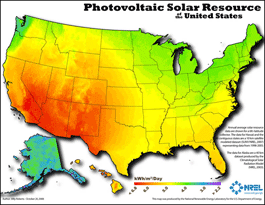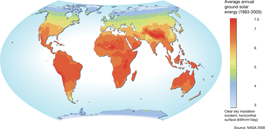Solar energy is sunshine

Source: National Renewable Energy Laboratory, U.S. Department of Energy

Source: National Renewable Energy Laboratory, U.S. Department of Energy

Source: United Nations Environment Programme (UNEP), NASA Surface meteorology and Solar Energy (SSE), 2008.
The amount of solar energy that the earth receives each day is many times greater than the total amount of all energy that people consume. However, on the surface of the earth, solar energy is a variable and intermittent energy source. The amount of sunlight and the intensity of sunlight varies by time of day and location. Weather and climate conditions affect the availability of sunlight on a daily and seasonal basis. The type and size of a solar energy collection and conversion system determines how much of the available solar energy we can convert into useful energy.
Solar thermal collectors
Low-temperature solar thermal collectors absorb the sun's heat energy to heat water or to heat homes, offices, and other buildings.
Concentrating collectors
Concentrating solar energy technologies use mirrors to reflect and concentrate sunlight onto receivers that absorb solar energy and convert it to heat. We use this thermal energy for heating homes and buildings or to produce electricity with a steam turbine or a heat engine that drives a generator.
Photovoltaic systems
Photovoltaic (PV) cells convert sunlight directly into electricity. PV systems can range from systems that provide tiny amounts of electricity for watches and calculators to systems that provide the amount of electricity that hundreds of homes use.
Millions of houses and buildings around the world have PV systems on their roofs. Many multi-megawatt PV power plants have also been built. Covering 4% of the world's desert areas with photovoltaics could supply the equivalent of all of the world's daily electricity use.



